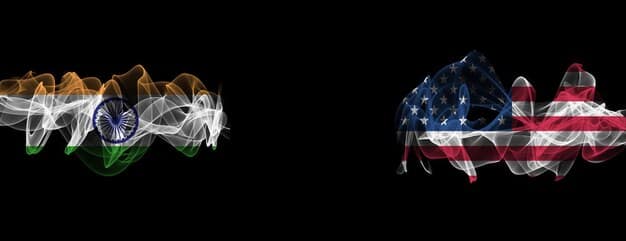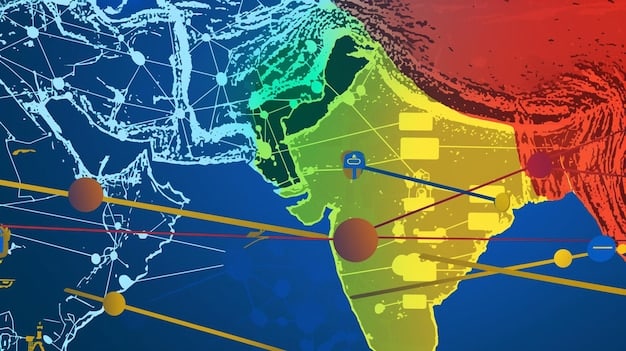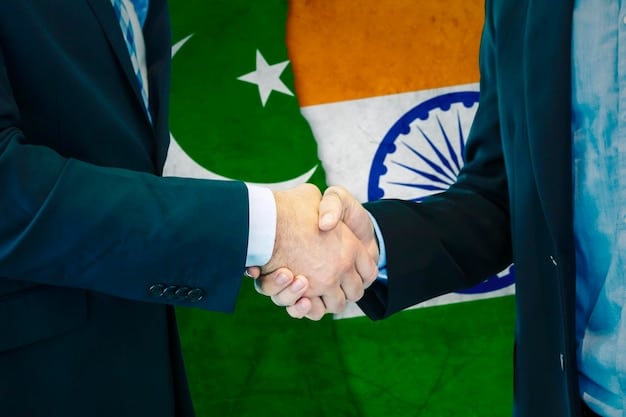US Response to India-Pakistan Conflict: Scenarios & Strategies

A potential military conflict between India and Pakistan would likely prompt the US to pursue diplomatic de-escalation, potentially leveraging economic and military aid to influence both nations, while also considering its strategic interests in the region and broader global implications.
Tensions between India and Pakistan are a persistent reality, and any escalation into a military conflict would inevitably draw international attention. The question of how will the US respond to a potential military conflict between India and Pakistan? is a crucial one, with implications for regional stability and global power dynamics.
Understanding the Dynamics of India-Pakistan Relations
To understand how the US might respond, it’s essential to grasp the historical and current dynamics of the India-Pakistan relationship. This relationship is complex and fraught with tension, stemming from historical disputes and ongoing issues. Understanding the intricacies of this relationship is key to anticipating US actions.
Historical Context of the Conflict
The roots of the conflict lie in the partition of British India in 1947, which created India and Pakistan. This division led to mass displacement and violence, setting the stage for decades of animosity and territorial disputes.
- The Kashmir dispute: The region of Kashmir has been a primary source of conflict, with both countries claiming it in full but controlling only parts of it.
- Indo-Pakistani Wars: Several wars have been fought, including in 1947, 1965, and 1971, each exacerbating the mistrust and hostility.
- Cross-border terrorism: Allegations of Pakistan-sponsored terrorism in India, particularly after the 2008 Mumbai attacks, have further strained relations.
These historical issues continue to influence the present-day relationship, making it volatile and prone to escalations.
US Strategic Interests in South Asia
The US has significant strategic interests in South Asia, which would heavily influence its response to a potential conflict. These interests include regional stability, counter-terrorism efforts, and containing China’s influence. Balancing these interests is a complex task for US foreign policy.
Maintaining Regional Stability
The US aims to prevent large-scale conflicts that could destabilize the region. A war between India and Pakistan could have far-reaching consequences, affecting trade routes, energy supplies, and regional security.

The US would likely work to de-escalate tensions to prevent a wider conflict.
Counter-Terrorism Efforts
Both India and Pakistan are crucial in the fight against terrorism. The US needs their cooperation to address terrorist threats emanating from the region. A conflict could divert resources and attention away from counter-terrorism efforts.
The US needs to maintain a working relationship with both nations to address mutual security concerns.
Furthermore, the US has a vested interest in preventing the proliferation of nuclear weapons. Both India and Pakistan possess nuclear arsenals, raising the stakes in any potential conflict. The US would likely pressure both sides to exercise restraint and ensure the security of their nuclear assets.
Potential US Responses: A Diplomatic Approach
In the event of a military conflict, the US would likely prioritize a diplomatic approach. This involves using its influence to mediate between the two countries and encourage de-escalation. Diplomatic efforts are the first line of defense in preventing further escalation.
Mediation and Negotiations
The US could offer its services as a mediator to facilitate negotiations between India and Pakistan. This could involve high-level talks, shuttle diplomacy, and behind-the-scenes negotiations.
- Encouraging dialogue: The US would urge both sides to engage in direct talks to address their grievances and find a peaceful resolution.
- Offering a framework for negotiation: The US could propose a set of principles or guidelines to help structure the negotiations.
- Leveraging international support: The US could work with other countries and international organizations to put pressure on both sides to negotiate.
A successful diplomatic effort would require careful balancing of interests and a willingness from both sides to compromise.
Economic and Military Aid as Leverage
The US has a history of providing economic and military aid to both India and Pakistan. This aid can be used as leverage to influence their behavior during a conflict. However, this approach needs careful consideration to avoid unintended consequences.
Conditional Aid
The US could make future aid conditional on de-escalation and adherence to international norms. This would send a strong signal that the US is serious about resolving the conflict peacefully.
However, this approach could also backfire if either country perceives it as a threat to their sovereignty or security.
Sanctions and Restrictions
In more extreme cases, the US could impose sanctions or restrictions on either country to pressure them to de-escalate. This could involve trade restrictions, asset freezes, and travel bans.

While sanctions can be effective, they can also have negative economic consequences and may not always achieve the desired results.
Furthermore, the US may consider providing military aid to one or both countries, depending on the circumstances of the conflict. This could involve providing defensive weapons, intelligence sharing, and logistical support. However, such actions could be seen as taking sides and could further escalate the conflict.
The Role of International Organizations
International organizations like the United Nations also play a crucial role in managing conflicts. The US can work through these organizations to build consensus and coordinate international efforts.
UN Security Council
The US could bring the issue to the UN Security Council, seeking a resolution calling for a ceasefire and negotiations. This would involve working with other members of the council to draft and pass a resolution that is acceptable to all parties.
A UN resolution could provide a framework for a peaceful resolution and legitimize international efforts to mediate the conflict.
Other International Bodies
Other international bodies, such as the International Court of Justice and the World Bank, could also play a role in resolving the conflict. The US could support these organizations’ efforts to provide legal frameworks and economic assistance.
The US can also leverage its relationships with other countries to put pressure on India and Pakistan. This could involve working with allies in the region, such as Afghanistan and Bangladesh, to promote stability and cooperation.
Conclusion
How will the US respond to a potential military conflict between India and Pakistan? is complex and multifaceted, influenced by its strategic interests, historical relationships, and the broader geopolitical context. The US would likely pursue a combination of diplomatic, economic, and military strategies to de-escalate the conflict and promote a peaceful resolution. Ultimately, the success of these efforts will depend on the willingness of both India and Pakistan to engage in constructive dialogue and compromise. The US role remains critical in navigating this volatile situation.
Key AspectsUS Actions
🤝 Diplomatic Engagement Mediate between India and Pakistan to encourage dialogue and de-escalation.
💰 Economic LeverageUse economic aid as a condition for peaceful behavior, applying sanctions if necessary.
🛡️ Military SupportOffer defensive weapons, intelligence sharing, and logistical support based on conflict specifics.
🌍 International Cooperation Work with UN and other bodies to build consensus and coordinate global conflict resolution efforts.
What is the US policy toward India and Pakistan?
The US policy aims to balance relations, fostering cooperation on counter-terrorism and regional stability while addressing concerns over human rights and democracy.
How does the US view the Kashmir conflict?
The US advocates for a peaceful resolution through dialogue between India and Pakistan, encouraging respect for human rights and international law in the region.
What are the potential economic impacts of a conflict for the US?
A conflict could disrupt trade routes, increase energy prices, and affect US investments in the region, prompting economic instability.
How might a conflict affect counter-terrorism efforts?
A conflict could divert resources and attention from counter-terrorism efforts, potentially allowing terrorist groups to exploit the instability.
What role could the US play in nuclear non-proliferation?
The US could pressure both countries to ensure nuclear security and exercise restraint, working through international bodies to prevent escalation.
How is the US likely to respond to this?
The US would likely try to take a multi-faceted approach, engaging diplomatically while assessing the economic situation.





